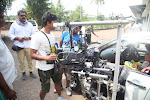20 Filmmaking Secrets Every Filmmaker Should Know
Filmmaking has tons of secrets, and every filmmaker has their own. Whether gained thru experience or accident, these secrets allow moviemakers to produce a movie cheaper, faster, and easier.
In this post, I’m going to reveal to you the top 20 secrets I’ve learned from producing a feature film.
NOTE: All secrets are to be taken as guidelines, or suggestions. Nothing below is an absolute rule. These are observations I’ve made over the years, writing, directing, and editing movies.
Below is a list of 20 filmmaking secrets every filmmaker should know:
1. Shoot Tight
By hiding poor production design and requiring less light, tighter shots – Medium Close-Up, Close-Up – tend to make low budget films appear more expensive for no extra cost.
2. Clutter the Background
Empty space is terrible – it looks cheap and low-budget.
Try filling up dead space with anything – curtains, stuffed animals, books, etc.
Having good set-design adds production value, characterization, and depth to your image.
Note: It’s best to have items that are complementary in texture and color. However, if this is not an option, it’s better to have something rather than nothing.
3. Add Depth
Too often, low-budget films place their actor directly in front of a wall. This creates a very flat and uninteresting image. Don’t do this!
Depth creates aesthetically pleasing images; it can orient the audience to the character’s surroundings, and allows for more interesting lighting.
Adding depth can be achieved by putting distance between the subject and the background, using a backlight on the subject, or using different hues and levels of lights in the fore, mid, and background.
One more tip – use objects that add depth to the walls such as books and knick-knacks.
4. Light on a Stick
It’s portable, light, and quick.
A light on a stick is versatile. Primarily used as a key light, it can quickly become a fill or back light. Also, with an extendable pole, it can be raised or lowered depending on the situation.
Other advantages include: maintaining a well-lit moving subject, faster set-up times, and quick adjustments.
5. Add Camera Movement
Camera movement can add a lot.
Whether subtle or in-your-face, camera movement gives energy to a scene. Watch any Tony Scott film, the camera is always moving, bringing the scene to life.
Plus, movement with dollies, cranes, jibs, steady-cams, etc. add value and make your project appear bigger. Look at movies like Transformers or The Avengers, the camera is constantly moving.
Shooting handheld is a cheap way to add camera movement – it quickens set-up time and allows shots to be easily adjusted, or reframed.
6. Cut the Fluff
This secret concerns both editing and writing.
Cut the fluff refers to removing what’s not important – If a scene, action, or dialogue doesn’t move the story forward, lose it.
Keep your audience engaged – make your story tight, concise, and full of meat, not fat.
7. Less Takes, More Coverage
Coverage will save your film from appearing slow, stale, and possibly dying.
Filmmakers argue, “Is a good take more beneficial than lots of coverage?” My answer is – No.
While performances are important and crucial, they do not offer the benefits coverage can offer, especially on a low budget film.
Coverage gives you options. Instead of being stuck with only a few angles and takes, coverage allows you to cut more frequently, holding the audience’s attention.
With more angles, your film will become more visually interesting. Allowing you to derive from the stale standards of WS, MS, and CU. Get creative.
Don’t be stuck having to use your WS because that’s all you had time to obtain because you were being a perfectionist. Instead, capture two takes of each angle and move on.
Additional coverage gives you the option to cut unnecessary dialogue or actions, speed up or slow down the pace, and cut away from bad acting.
8. Film Multiple Lead-Ins
Lead-Ins are shots that begin a scene or new beat.
Filming multiple lead-ins allows you to choose where to start a scene in post. Maybe your original plan doesn’t pan out. But, if you have a second or third lead-in, you can, without fretting, start the scene wherever works best.
Also, extra lead-ins give you the option to remove entire beats from your film, if later they are bogging down your story.
9. Forget Prime Lens, Use a Variable Zoom
Many cinematographers will only use Prime Lenses. Primes and Zooms both have advantages and disadvantages, but a variable zoom offers more benefits to the indie.
For starters, a variable zoom gives you instant results; there is no wait time to switch lenses.
Second, the audience can’t tell the difference. Sure, most DPs think they can tell the difference, but odds are your movie isn’t being shown to a theatre filled with DPs. This is just ego talking. Drop the primes and save both time and cash.
Finally, a variable zoom lens can perform zooms. Too many times, a zoom can add dramatics or intensity to a good performance; gives the dialogue more weight.
Lenses are often a decision made by the ego; don’t waste time and money because of yours or your DP’s.
10. Punch-In
Punching-In refers to capturing a WS or MS, then zooming in to get a closer shot. This process takes only a few seconds or minutes, depending on the length of your scene, and will give your actor an additional take while giving you more coverage.
Note: When you punch-in, adjust your lights in as well. This will prevent you from accidently under exposing your image. Also, check your focus.
11. Use Music in Every Scene
Lack of music is a dead give-away that a movie is low-budget.
Music pushes your narrative forward and helps convey the mood/tone. In addition, it can invisibly string together scenes, making transitions smooth and natural.
A good score can mask mistakes, long pauses, or abrupt edits.
12. Let the Sound Make the Cut
Sound can bridge the gap between what is seen and perceived.
Often two clips won’t sync perfectly, but adding sound in-between the shots makes the transition smooth, even if visual information is missing – If people hear it, they see it.
Extra Tip- If filming a shoot-out or chase scene, add swooshes in-between shots. The sound will add umph to the cuts, giving your traveling subject more impact on screen.
13. Obtain a Clean Dialogue Track
At the end of each day, have your sound recordist step aside, preferably in a quiet area, with the actors and have the actors/actresses say all of their lines for the day, in character.
Clean dialogue tracks will get you out of some tight spots.
Often, during editing, you’ll need to manipulate the actor’s dialogue by adding an “and” or “but” in between words; a clean dialogue track will allow you to do this, seamlessly.
As a bonus, a clean dialogue track will improve your odds of avoiding ADR.
14. Budget for Deliverables
Deliverables are a curse to filmmakers. They consist of all the annoying details that you never thought of, or new existed, until the day you sign a distribution deal.
I suggest raising an additional ten grand for your budget, and hire a professional to handle your deliverables; trust me, this will save you lots of time and headaches.
15. Avoid Water Bottles, Use a Water Cooler
Water bottles, while convenient, are expensive and wasteful.
Every hour someone will walk to the craft services, open a bottle of water, take a sip, and set it down, never to be drank from again. REPEAT ALL DAY.
Instead, use a water cooler. They’re inexpensive and reusable- friendly to the environment and your budget. Plus, a water cooler holds more ounces of liquid than a large package of water bottles. Using cone shaped cups will also insure you don’t end the day with dozens of cups sitting around your set.
16. Make a Check List
Check lists are a must.
Have one for every department: shots, equipment, costumes, actors, etc.
Having a check list will ensure that you won’t forget anything, and free your mind to focus on more important matters.
17. Check Costume Shops for Wardrobes (discounts)
This is a money saving secret that I didn’t learn until after I purchased the wardrobes for Killer School Girls from Outer Space.
Most costume shops offer filmmakers discounts and extended rental times.
18. Create a Color Scheme
A color scheme, while difficult to control on a low-budget, adds a lot of production value; making your film appear more expensive and more aesthetically pleasing to your audience.
19. Think Outside the Box
A secret I’m sure you’ve all heard, but it’s true!
Be innovative, take risks, and break the rules.
Thinking outside the box is what filmmaking is all about!
20. Have FUN
Remember, filmmaking is fun!
Yes, you have a responsibility to make an awesome film, bring the project in on time and under budget, but don’t forget to have a good time too; it’s the reason you wanted to become a filmmaker instead of an accountant.
Throughout the process of making a film you’re sure to pick up some tricks of the trade. Above are20 filmmaking secrets I think you should know.







0 Comments